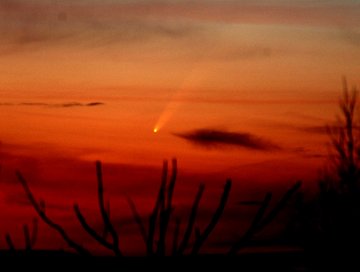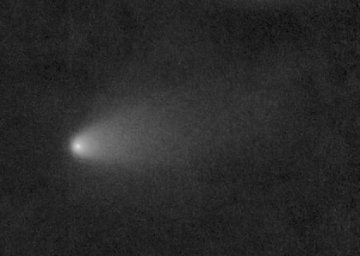 Did you sleep through the auroras of Dec. 14th? Next time get a wake-up call: Spaceweather PHONE.
Did you sleep through the auroras of Dec. 14th? Next time get a wake-up call: Spaceweather PHONE.
GREAT COMET: When the sun sets tonight, go outside and look west. You may see the brightest comet in thirty years hanging just above the horizon. It's Comet McNaught (C/2006 P1).
Last night, "as the comet descended in the west, it turned reddish and seemed to glow very brightly--almost like a spark or ember. Awe inspiring!" reports Leslie Sheldon of Kanata, Ontario. "I can only imagine what it would look like in truly dark skies."
"After receiving a Space Weather alert on my cell phone, I drove straight to the highest point in the area," adds Sal Viviano of Washington, Michigan. Looking down at McNaught, he was rewarded by this "brief but beautiful" view:

Comet McNaught Photo Gallery
[finder chart] [ephemeris] [3D orbit]
In the days ahead, Comet McNaught will pass the sun (temporarily disappearing in the glare) and emerge in good position for southern hemisphere viewing later this month. Meanwhile, solar heating will continue to puff up the comet, causing it to brighten even more. It could become one of the brightest comets in centuries, visible even in daylit skies. Read on...
IN BROAD DAYLIGHT: "This is the brightest comet I've ever seen!" says Sean Walker of Sky and Telescope. Thus inspired, he decided to photograph Comet McNaught in broad daylight:

"I took this picture from my observatory in Chester, New Hampshire on Jan. 10th at 8:38 EST ," he says. At the time, the comet was only 11 degrees from the Sun! "I used a 178mm Maksutov-Newtonian telescope with a Lumenera LU075 webcam equipped with a Baader IR-pass filter (685nm-800nm)."

